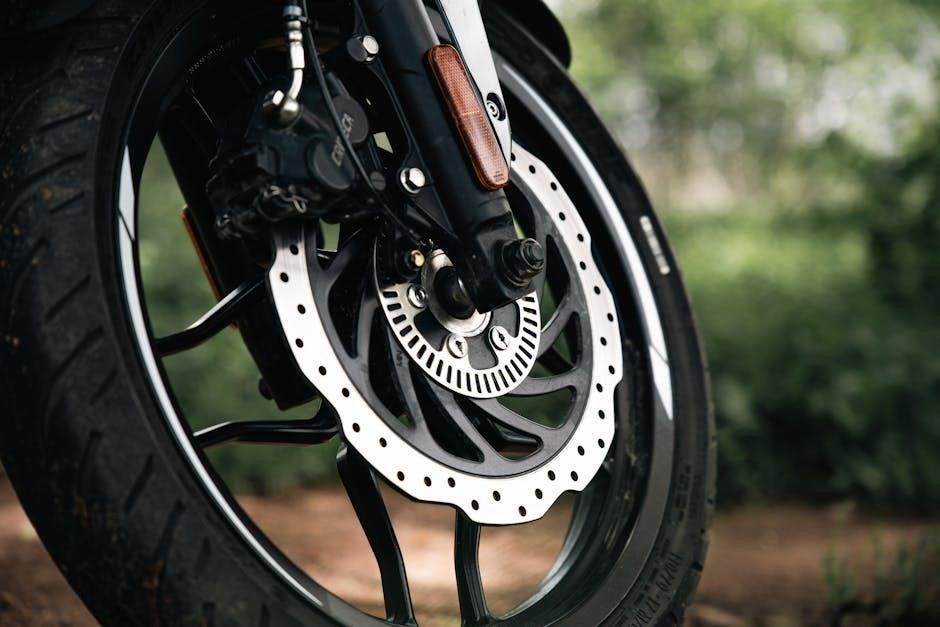bike measurement guide

Proper bike sizing is essential for comfort, efficiency, and preventing injuries. Measuring height and inseam helps determine the ideal frame size, ensuring a perfect fit for any cycling style.
Why Proper Bike Sizing is Important
Proper bike sizing ensures a comfortable and efficient riding experience. A well-fitted bike reduces the risk of injuries, such as back pain or joint strain, caused by an ill-suited frame size. When your bike is the right size, it improves pedaling efficiency and handling, making rides more enjoyable. Conversely, a bike that’s too small or too large can lead to discomfort and fatigue. Additionally, proper sizing enhances control and safety, as the rider can maneuver the bike more effectively. Whether for road, mountain, or city cycling, the right fit maximizes performance and reduces long-term health risks. Taking the time to measure and select the correct size is crucial for both casual riders and serious cyclists. A bike that fits properly is an investment in your cycling experience, ensuring every ride is as comfortable and enjoyable as possible.
How to Measure for Your Bike
Measure your height and inseam accurately to determine the ideal bike size. Both measurements ensure a proper fit, enhancing comfort and performance during rides.
Measuring Your Height and Inseam
To accurately determine your bike size, start by measuring your height and inseam. Stand barefoot and measure your height from the floor to the top of your head. For inseam, measure the distance from the floor to your crotch while standing upright. Use a tape measure or a string to get precise measurements. Ensure consistency by measuring with or without shoes, but maintain the same method for both measurements. These metrics are crucial for matching your body proportions to the correct bike frame size. Inseam is often considered more accurate for bike sizing, as it reflects your leg length and riding comfort. By combining both height and inseam, you can achieve a more personalized fit, ensuring optimal comfort and performance during your rides.
Calculating Your Frame Size
Calculating your frame size involves using your height and inseam measurements. For most bikes, the formula is specific to the type: road bikes use 0.70 of your inseam, while mountain and city bikes use 0.685. Measure your inseam in centimeters, multiply it by the appropriate factor, and round to the nearest whole number to find your frame size. For example, if your inseam is 80cm, a road bike frame would be 56cm (80 x 0.70), while a mountain bike would be 55cm (80 x 0.685). Keep in mind that frame sizes vary slightly between manufacturers, so always cross-reference with their specific charts. If you fall between two sizes, consider your riding style—larger frames offer more comfort, while smaller frames provide better maneuverability. This calculation ensures a balanced fit for optimal performance and comfort.
Types of Bikes and Their Sizing
Different bike types—road, mountain, and city/commuter—have unique sizing considerations. Road bikes prioritize efficiency, mountain bikes focus on stability, and city bikes emphasize comfort, each requiring tailored measurements for optimal fit.
Road Bikes: Sizing Considerations
Road bikes are designed for speed and efficiency, making proper sizing critical for optimal performance. To determine the right size, measure your height and inseam, then use the formula: frame size = inseam (cm) × 0.70. This ensures a comfortable riding position. Standover height is also essential, with a 1-2 cm clearance for safety. Handlebar reach and stack height are key; a lower stack suits aggressive riding, while a higher stack offers comfort. Road bikes vary in frame geometry, with race bikes having shorter wheelbases and endurance bikes offering a more relaxed position. If you’re between sizes, test ride or consult a professional to ensure the best fit. Proper sizing enhances efficiency, reduces discomfort, and improves overall cycling experience.
Mountain Bikes: Sizing Considerations
Mountain bike sizing focuses on comfort and control for off-road riding. To find your ideal frame size, use the formula: frame size = inseam (cm) × 0.685. This ensures a balanced position for maneuverability. Standover height is crucial, with 2-4 cm of clearance for safety. Handlebar width should match your shoulder width for better control. Mountain bikes often have longer wheelbases for stability, but shorter chainstays improve agility. Suspension travel and tire size also affect fit, so consider these when choosing. If you’re between sizes, test the bike to ensure optimal handling. Proper sizing enhances control, reduces fatigue, and improves overall performance on trails. Always consult a professional if unsure, as sizing can vary by brand and bike type.
City and Commuter Bikes: Sizing Considerations
City and commuter bikes prioritize comfort and practicality. To determine the right size, use the formula: frame size = inseam (cm) × 0.685. This ensures a comfortable riding position. Upright handlebars are common, allowing a relaxed posture. Standover height should provide 2-4 cm of clearance for easy mounting. Seat height should allow a slight bend in the knee when the pedal is at its lowest. Handlebar height should match your preference for comfort. Accessory compatibility, like racks or fenders, is also a consideration. While size charts are helpful, personal comfort and riding habits play a significant role. Always test the bike if possible, as sizing may vary slightly between brands. Proper sizing ensures a smooth, enjoyable commute.

Bike Size Conversion Charts
Bike size conversion charts are essential tools for matching your height and inseam to the appropriate frame size. These charts vary by bike type and manufacturer, offering a standardized guide for road, mountain, and city bikes. While they provide a useful starting point, they don’t replace a professional bike fit. Most charts use height and inseam measurements to determine frame size, with formulas like inseam (cm) × 0.685 for city bikes. Charts also account for standover height and handlebar reach. However, sizing can vary slightly between brands due to differences in frame geometry. Always consult the manufacturer’s specifications for accuracy. Using a conversion chart ensures a well-fitting bike, enhancing comfort and performance. It’s a practical first step in finding the perfect bike for your needs.

Factors Affecting Bike Fit
Bike fit is influenced by multiple factors beyond frame size. Riding style plays a significant role, as road bikes prioritize efficiency and aerodynamics, while mountain bikes focus on stability and control. Handlebar height and reach are crucial, affecting posture and comfort. Saddle height and position are equally important, ensuring proper leg extension and preventing discomfort or injury. Pedal type and shoe compatibility also impact performance, particularly for clipless systems. Additionally, body proportions, such as arm and leg lengths, can require adjustments to stem length and crank size. Even small details like tire size and frame geometry can affect the overall fit. A professional bike fit can fine-tune these elements, optimizing comfort and efficiency for a personalized riding experience.

Manufacturer Specifications
Manufacturers provide precise sizing charts and frame geometries, varying by bike type. These specs ensure compatibility with intended riding styles and body measurements, optimizing performance and comfort for each rider.
Standard Bike Sizes by Manufacturers
Manufacturers typically offer standard bike sizes, ranging from extra small (XS) to extra large (XL), with specific frame dimensions tailored to rider height and inseam. These sizes are designed to align with the average measurements of cyclists, ensuring optimal fit and performance. For example, road bikes often use a formula where frame size is approximately 0.70 times inseam length, while mountain bikes use around 0.685. City bikes may follow similar ratios but prioritize comfort over efficiency. Brands like Cannondale and Trek provide detailed sizing charts, reflecting their unique frame geometries. While there’s some consistency across brands, slight variations exist, so it’s crucial to consult the specific manufacturer’s guide. Proper alignment with these standards ensures a bike that matches both body proportions and riding style, enhancing comfort and efficiency for cyclists of all levels. Always verify measurements against the manufacturer’s specifications for the best fit.
How to Use Your Bike’s Owner’s Manual
Your bike’s owner’s manual is a crucial resource for ensuring proper fit and functionality. It provides specific details about the bike’s design, including frame size, wheel dimensions, and recommended tire size. Manufacturers often include sizing charts tailored to their bike models, which can help you verify if the bike matches your measurements. To use the manual effectively, start by locating the sizing section, which typically correlates height and inseam with frame size. Cross-reference these measurements with your own to confirm the best fit. Additionally, the manual may offer guidance on adjusting components like handlebars and seat height for optimal comfort. Always consult the manual before making adjustments, as it contains model-specific instructions. By following these guidelines, you can ensure a safe and efficient riding experience, tailored to both your body and the bike’s design. This step is essential for maximizing performance and comfort.

Common Mistakes to Avoid
When determining your bike size, several common mistakes can lead to discomfort or poor performance. One major error is relying solely on height without considering inseam, as this can result in an ill-fitting frame. Another mistake is ignoring the differences between bike types; road, mountain, and city bikes have varied sizing standards. Some riders also overlook the importance of proper riding position, such as handlebar height and seat adjustment, which can significantly affect comfort. Additionally, using outdated or incorrect sizing charts can misguide frame size selection. It’s crucial to measure accurately and consult the manufacturer’s guidelines to avoid these pitfalls. Ensuring a precise fit enhances riding efficiency and reduces the risk of injury, making it essential to avoid these common mistakes during the sizing process. Always double-check measurements and consider professional advice if unsure. Proper sizing is key to an enjoyable cycling experience.
Proper bike sizing is a critical aspect of ensuring a comfortable, efficient, and injury-free cycling experience. By accurately measuring height, inseam, and considering bike type, riders can match their physique to the ideal frame size. Sizing charts and manufacturer guidelines serve as valuable tools, but individual adjustments are often necessary for optimal fit. Avoiding common mistakes, such as relying solely on height or ignoring bike-specific sizing standards, helps prevent discomfort and performance issues. Investing time in precise measurements and consultations with experts can significantly enhance your cycling journey. Remember, a well-fitting bike not only improves performance but also makes every ride more enjoyable. Always prioritize proper sizing to unlock the full potential of your cycling experience and ensure long-term satisfaction with your bike.





